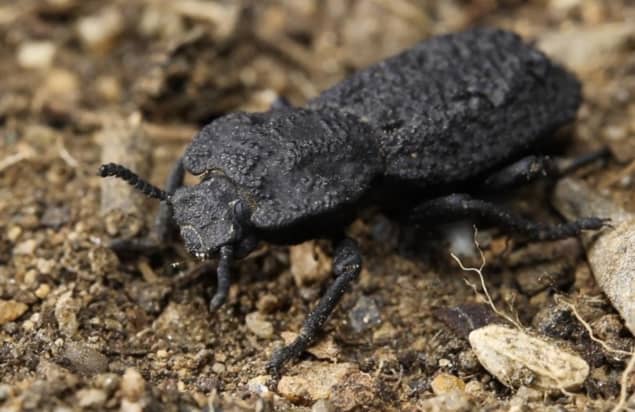Uncrushable beetle reveals its strengths to scientists
23 Oct 2020

The toughening mechanisms that make the diabolical ironclad beetle extremely resistant to crushing have been uncovered by researchers in the US and Japan. David Kisailus at the University of California, Riverside and colleagues found that interlocking sutures in the exoskeletons of the insects allowed them to stiffen when under stress. The team then created artificial materials inspired by this design – which could allow engineers to develop better techniques for fastening objects together.
Engineers have a wealth of techniques at their disposal for joining dissimilar materials together: including welding, gluing, and mechanical fastening. However, these joins tend to fail when subjugated to crushing and high-stress impacts. Over many millions of years of evolution, a variety of plant and animal species have found highly sophisticated solutions to this problem. One particularly striking example is the diabolical ironclad beetle, which inhabits the deserts of southern California. The secret to the ironclad’s toughness lies in its exoskeletal forewings, or elytra, which allow it to easily withstand impacts during attacks from predators.
Compression tests
In their study, Kisailus’ team studied the properties of the ironclad’s elytra in detail to understand why they are so resistant to crushing. Firstly, they performed compression tests on exoskeletons of the insects. As stress increased, they observed the structures becoming stiffer – enabling them to withstand a maximum force close to 39,000 times their own weight. Strong bonds: cross section of the medial suture, where two halves of the diabolical ironclad beetle’s elytra meet, showing the jigsaw puzzle configuration. (Courtesy: Jesus Rivera/UCI)
Strong bonds: cross section of the medial suture, where two halves of the diabolical ironclad beetle’s elytra meet, showing the jigsaw puzzle configuration. (Courtesy: Jesus Rivera/UCI)
 Strong bonds: cross section of the medial suture, where two halves of the diabolical ironclad beetle’s elytra meet, showing the jigsaw puzzle configuration. (Courtesy: Jesus Rivera/UCI)
Strong bonds: cross section of the medial suture, where two halves of the diabolical ironclad beetle’s elytra meet, showing the jigsaw puzzle configuration. (Courtesy: Jesus Rivera/UCI)In the main part of the study, Kisailus and colleagues used high-resolution microscopy – including computerized tomography and scanning electron microscopy – to uncover the multiscale architectures responsible for this stiffening. Whereas the elytra in most beetles are free to move independently, the team’s images revealed unique medial sutures that permanently fused both parts of the ironclad’s elytra together. These sutures used interlocking jigsaw-puzzle arrangements of ellipsoidal blades (see figure: “Strong bonds”).
Next, the researchers created 3D-printed replicas of these sutures and subjected them to high stresses in the lab. These tests revealed that the interlocking blades did not suddenly snap at their thinnest points to release stress; instead, they gave way gradually as the blades split apart into layers, which remained connected by fibre bridges. This meant that mechanical failure could occur gradually.
Finally, Kisailus and colleagues used carbon fibre-reinforced elements to create artificial sutures from interlocking blades. This enabled them to fuse segments of aircraft made from different materials, without the need for rivets or fasteners – which can fail catastrophically when too much stress is applied. By clearly demonstrated the superior qualities of their bio-inspired material, the team hopes that their discoveries will lead to tough, impact- and crush-resistant structures for joining dissimilar materials together.
The study is described in Nature.
Sam Jarman is a science writer based in the UK.
from physicsworld.com 11/2/2022
Δεν υπάρχουν σχόλια:
Δημοσίευση σχολίου